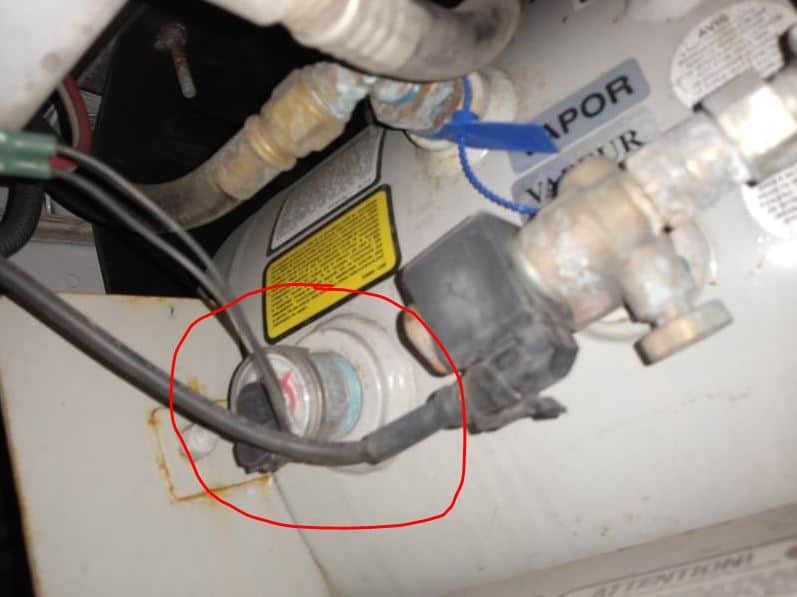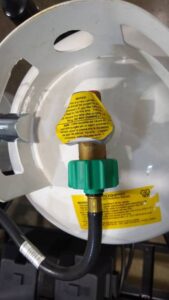It’s November 14th. You’re using the RV as a base camp during hunting season. After a long, icy day in the blind, you’ve returned to the RV dreaming of a steamy shower – and the d*mn water is coming out cold!
Most of us would think, “I’m out of propane.” And if, like most RVs, yours has an automatic changeover regulator for dual propane tanks, you might manually switch the regulator from Tank A to Tank B. Then, if Tank B produces the same tepid result, you might throw up your hands in frustration, assume both tanks are empty, and abandon ship.
But you’ve likely fallen prey to an incorrect assumption. Your tanks aren’t empty; they’re just low. And Mother Nature turns stingy when the mercury drops.
How Do I Measure How Much Propane I Actually Have?
Before I explain, let me acknowledge an oversight: Your RV manufacturer didn’t make it easy to measure your propane tank levels. You have battery and water tank monitors, but likely no propane tank monitor. What gives?
If you have a motorhome with an ASME propane tank, you’ll have to read the float gauge. Hopefully, your RV manufacturer placed the ASME tank behind an exterior access door and didn’t hide it behind the axle, tucked underneath the chassis, practically invisible (looking at you, Renegade Vienna!).

If you have a towable RV, you usually have two DOT 20-, 30-, or 40-lb propane tanks. There’s likely no direct way to measure their fill level. Instead, you probably have an automatic changeover regulator. When one tank is empty, the regulator switches to the other tank, the plastic indicator swivels from red to green, and if you’re lucky enough to remember to check the regulator (likely buried under a plastic cover or tucked in the dark recesses of a compartment), you’ll know it’s time to refill the first tank.
Yeah … it’s frustrating. There are several aftermarket products that purport to solve this problem. Some, like the $20 outlet pressure gauges or $5 magnetic strips, are rather inaccurate. Others, like the fish scales, are quite precise, but not everyone wants to lift a 30-lb steel tank at shoulder height (can you say, “chiropractor”?). The best solution, IMHO, is the Mopeka ultrasonic sensor system.
Why Propane Becomes a Problem In Wintry Weather: Vaporization Rates

But I’m getting off-topic. Now that I’ve apologized for the difficulty in knowing what’s inside your propane tanks, let me explain the problem with propane and cold-weather RVing.
Today’s exciting topic: the vaporization rate of propane. And before you nod off, just remember that I could be saving you the hassle of waking up with frozen toes or gritting your teeth through cold winter showers!
Propane boils at -44 degrees Fahrenheit. That’s far colder than ‘most anywhere outside of Antarctica, so we store it at high pressure, which condenses the bulk of the propane into a liquid with a little vapor filling the rest of the tank.
It’s that propane vapor, the gas, that does all the work. In fact, tanks are designed so that liquid propane should never enter your system. Propane vapor is drawn through your regulator when you turn on a gas-fired appliance. As you use propane vapor, more liquid inside the tank evaporates, which restocks the vapor, which is then sucked into the regulator … ad infinitium. It’s beautiful in its simplicity.
But there’s a catch. The liquid propane inside your tank can’t evaporate on its own. It needs heat. If that doesn’t make sense, email me, and I’ll happily get sidetracked by a long but fascinating conversation involving the Ideal Gas Law and the latent heat of vaporization … but for now, take my word for it. No heat = no vapor flow.
Your Propane Needs a Heat Source!
Where does this heat come from? Remember, propane boils at -44 degrees Fahrenheit. As long as you’re camping anywhere outside of the Arctic circle, propane is under the impression it’s warm and sunny. It absorbs heat from the air through the tank’s metal walls, and that’s the “heat engine” that keeps the vaporization going.
Let me land this plane. In short, liquid propane needs heat to turn into propane vapor, which actually does all the work inside your RV. This heat comes from the outside air, and this brings us to November 14th and your lukewarm, unpleasant shower.
Have you spotted the problem yet? As the air temperature decreases, propane vaporizes more slowly. Plus, as physics would have it, the emptier the tank, the slower the heat transfer! It’s a double whammy. Check out this table of propane vaporization rates for DOT containers:
Propane DOT Bottle Vaporization Rates
| 20-LB DOT PROPANE BOTTLE | |||||
| % FULL | #ERROR! | 0F | -5F | -10F | -15F |
| 60 | 36000 | 18000 | 12750 | 8500 | 4250 |
| 50 | 32400 | 18200 | 12150 | 8100 | 4050 |
| 40 | 28800 | 14400 | 11400 | 7600 | 3800 |
| 30 | 25200 | 12600 | 10450 | 7300 | 3150 |
| 20 | 21600 | 10800 | 8100 | 5400 | 2700 |
| 10 | 16200 | 8100 | 6075 | 4050 | 2025 |
| 30-LB DOT PROPANE BOTTLE | |||||
| % FULL | #ERROR! | 0F | -5F | -10F | -15F |
| 60 | 50400 | 25200 | 17850 | 11900 | 5950 |
| 50 | 45360 | 25480 | 17010 | 11340 | 5670 |
| 40 | 40320 | 20160 | 15960 | 10640 | 5320 |
| 30 | 35280 | 17640 | 14630 | 10220 | 4410 |
| 20 | 30240 | 15120 | 11340 | 7560 | 3780 |
| 10 | 22680 | 11340 | 8505 | 5670 | 2835 |
| 40-LB DOT PROPANE BOTTLE | |||||
| % FULL | #ERROR! | 0F | -5F | -10F | -15F |
| 60 | 60120 | 30060 | 21293 | 14195 | 7098 |
| 50 | 54108 | 30394 | 20291 | 13527 | 6764 |
| 40 | 48096 | 24048 | 19038 | 12692 | 6346 |
| 30 | 42084 | 21042 | 17452 | 12191 | 5261 |
| 20 | 36072 | 18036 | 13527 | 9018 | 4509 |
| 10 | 27054 | 13527 | 10145 | 6764 | 3382 |
Is This Something I Should Be Concerned About?
Now, don’t misunderstand what I’m saying. Propane still contains the same embodied energy in cold weather. You don’t lose BTUs! But you can’t access those BTUs via vapor as quickly.
If you’re camping above 30-40 degrees, this phenomenon is rarely a problem. But once you dip below freezing, the penalty becomes severe.
Let’s say you’re running the furnace (20,000 BTUs), the water heater (8,000 BTUs), and two stove burners (6,000 BTU each). That’s a total of 40,000 BTUs. At 20 degrees Fahrenheit, your 20-lb DOT propane bottle can’t keep up if you’re not at least ~70% full! Seventy percent!
If you have a tankless water heater, remember these draw 40,000-60,000 BTUs alone. These appliances, along with furnaces, are the “gas hogs” of your RV, and they will be most affected when cold-weather camping.
How Do I Use My Propane In Cold Weather?
The solutions are actually quite simple.
- Keep your tank full. Or keep a spare full tank onsite.
- Use the biggest tank you can. If you’re camping seasonally, ask your local propane company about a seasonal tank rental.
- Heat your tank. Wrap it in a 12V tank heating blanket, for instance.
Good luck, and stay warm!
Leave a Reply